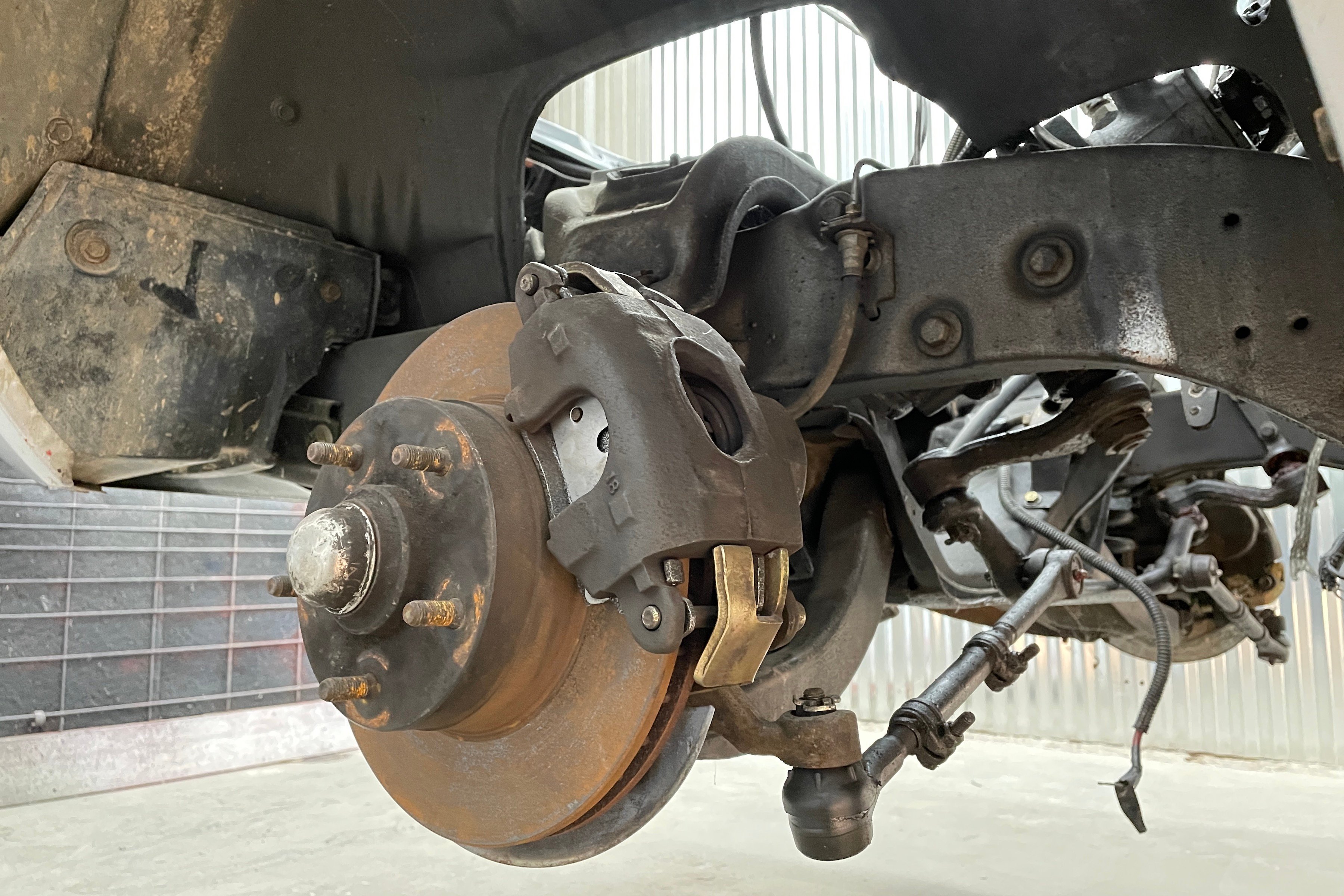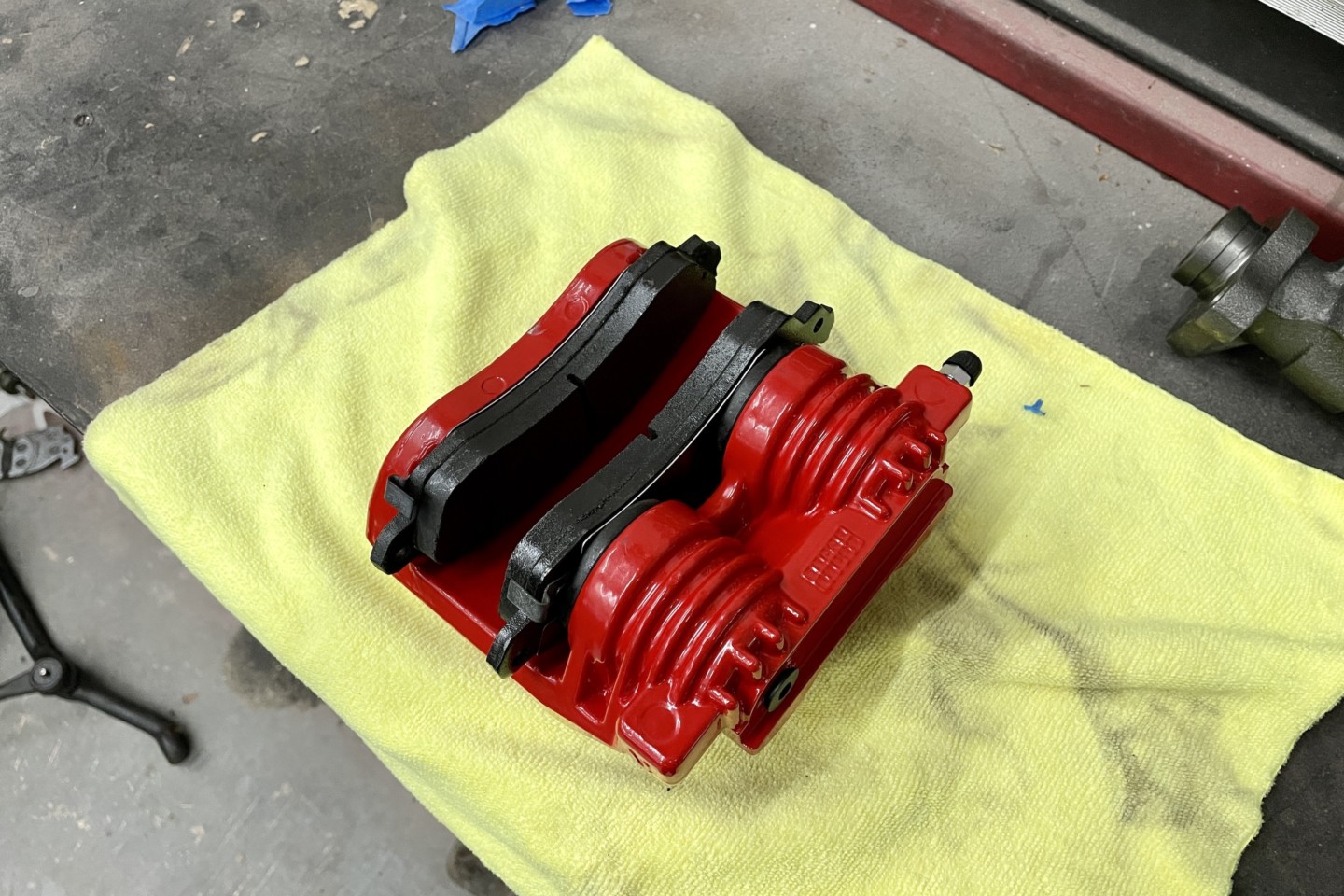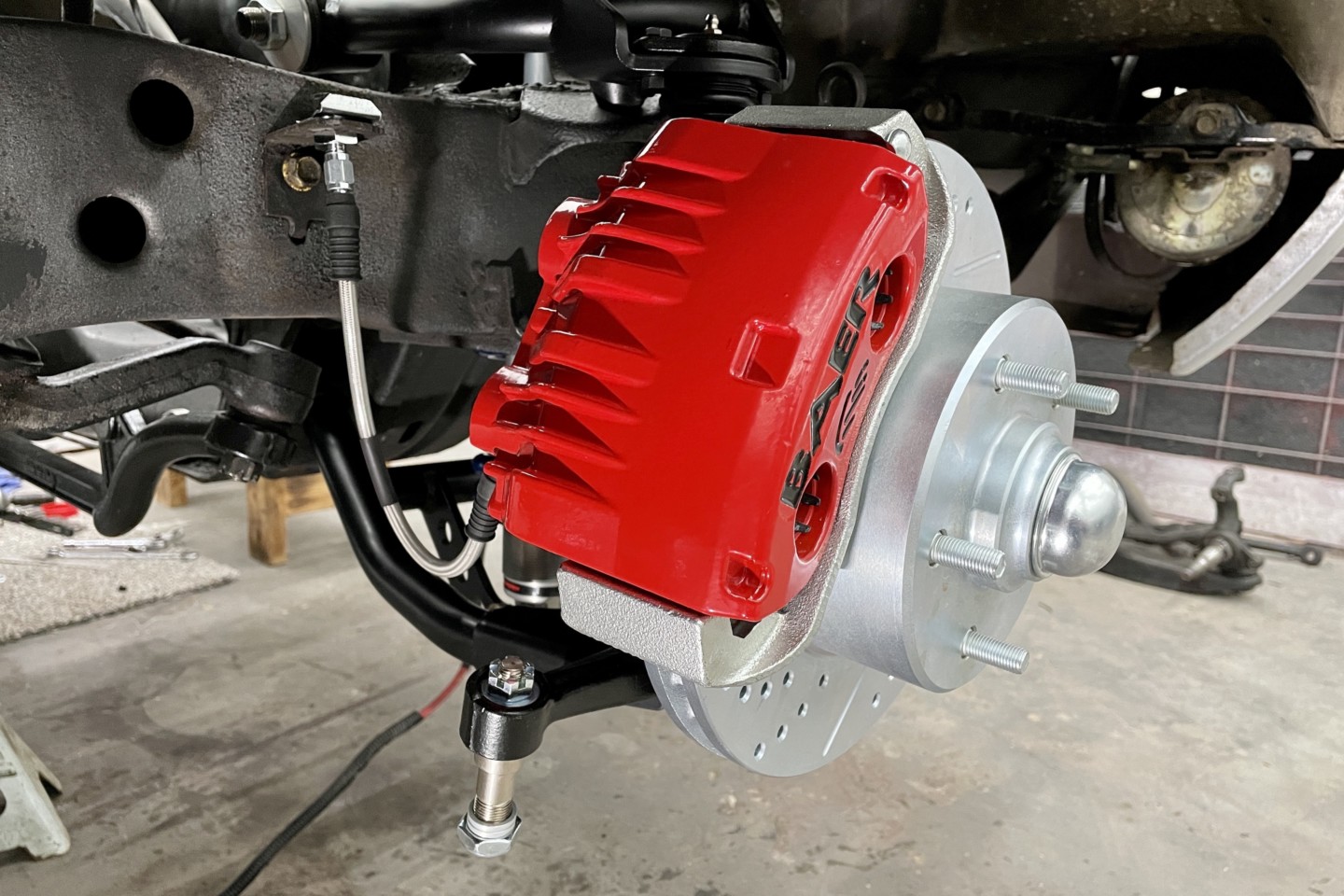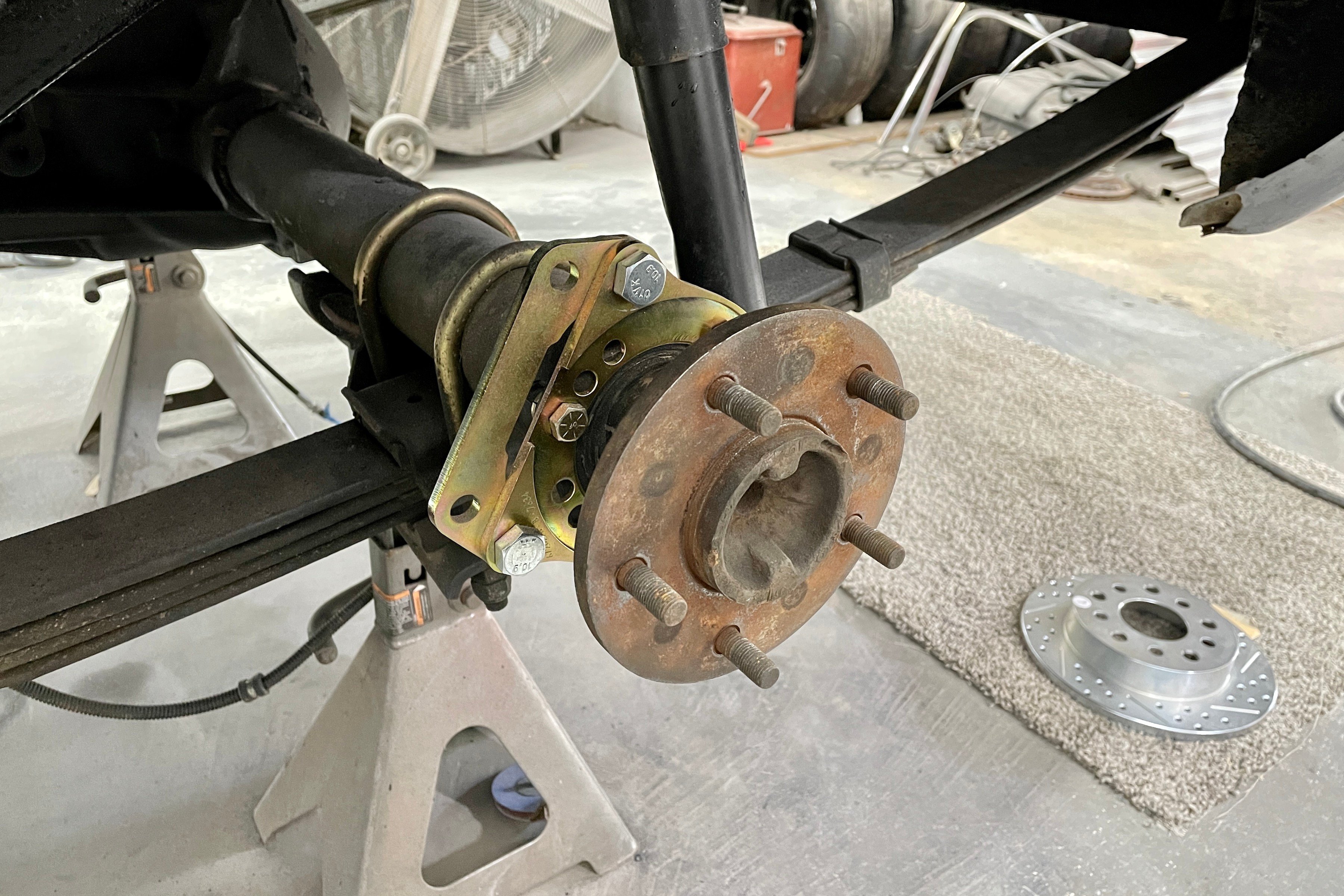In 1969, disc brakes were the exception and not the standard. It wasn’t until 1972 that brakes began to catch up to the power that muscle cars were creating. Even with the rapid improvements in braking during the early 70s, brake technology was still in its infancy. Savvy car enthusiasts changed from drum to disc as early as quality kits were available, many of which used factory disc brakes as the foundation of their conversion kits.
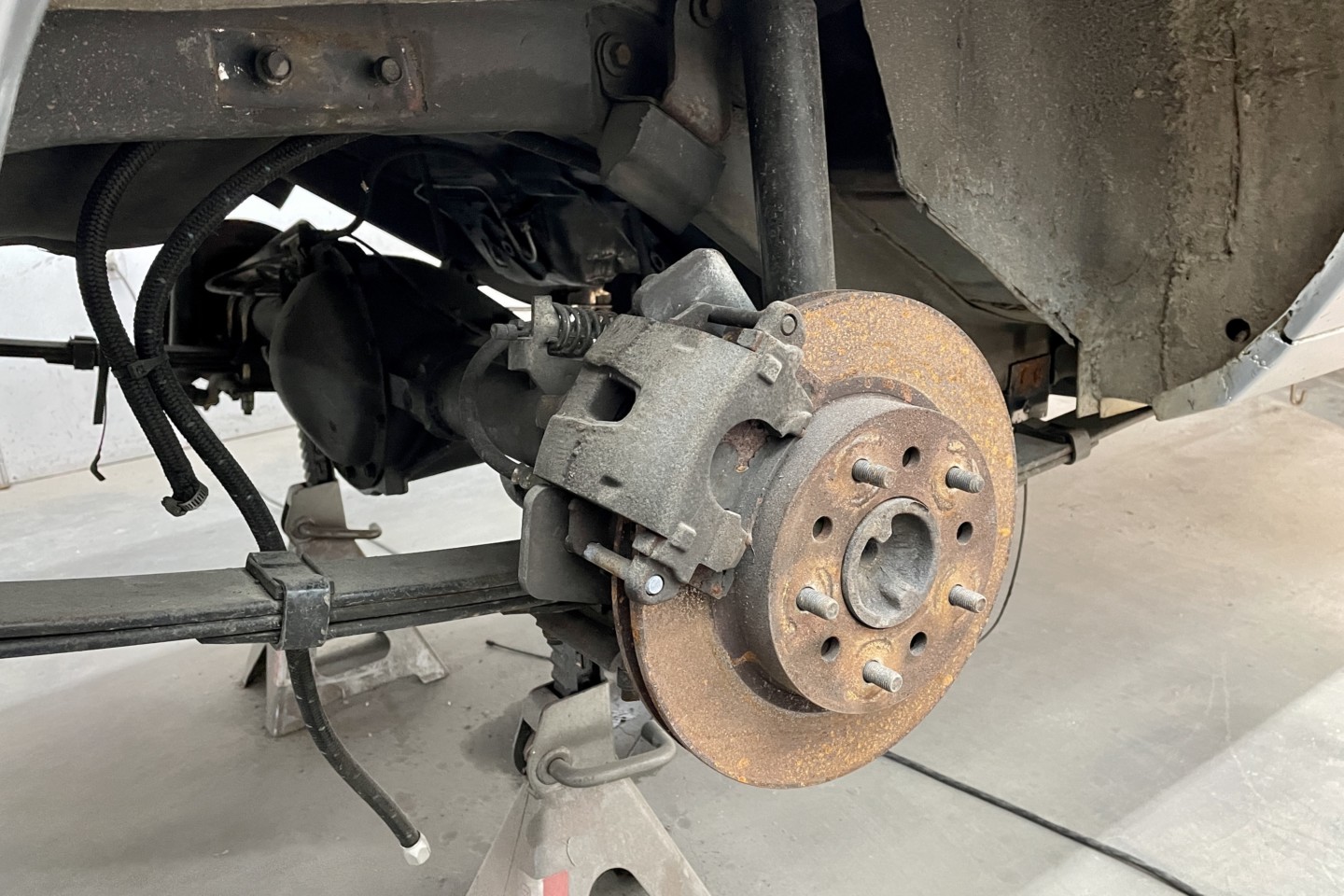
The Camaro’s aging brake upgrade appeared to be an OEM-style caliper adapted to fit an original drum brake application.
These early conversion kits were decent for the time, but technology continues to march on. What was great one day turned out to be simply mediocre the next. The velocity of technology slowed in the late 90s, but technical knowledge, new materials, and manufacturing advancements continue to improve automotive brake systems through today. We took on the question of when is it time to replace a previously upgraded brake system with a modern disc brake kit from Baer Brakes.
Our Quandary
We were approached with a common predicament, yet one that the crew had not really dug down deep enough to find the core answer. When do you upgrade and replace a previously upgraded replacement part? It is often difficult to figure out when a technical advantage has aged to the point where it should be enhanced with a modern system.
Case in point: We found a 1969 base Camaro that had a major brake system improvement performed in the late 1990s. The car had rolled off the assembly line with four-wheel manual drum brakes. Manual drum brakes on all four wheels were standard for all base models in 1969, but there was a power assist option for cars with drum brakes. Front disc brakes were included in the SS models and were mandatory in the Z28 RPO cars.

Baer Brakes’ Classic Series brake kits are designed to have the original Baer Brakes looks, fit in stock-style wheels, yet incorporate modern manufacturing and material technology for higher performance.
GM’s stock disc brakes were a single-piston design that worked decently when all the cars running around on surface streets had drum or early disc brakes. The factory parts department began offering the racing disc brake system that was developed to support the Z28’s Trans-Am racing program as an over-the-counter kit in 1968.
The kit was offered as a factory-installed option in 1969 and the legendary JL8 brake system was available for any Camaro model. This option was listed at $500.30 for SS and Z28 models, or $623.50 for base models. This was a good deal of money at the time. Calculating the inflation rate of 3.89 percent a year from 1969 to today, the JL8 brake option would cost about 3,641 of today’s dollars. It is easy to see why only 206 JL8 units were sold on factory-made Camaros.
We were going from this... to this!
Initial Upgrade
At some point in the late 90s, the owner of this Camaro realized that disc brakes were safer in traffic and bought an early disc brake conversion kit. As with many of these kits, this conversion used OE-style calipers and pads that used brackets to fit within stock wheels. Most required changing the master cylinder, removing the residual pressure valve, and adding a metering valve. Before you begin any brake upgrade, it is a good practice to take an inventory of what you have to work with. This includes everything in the brake system, including brake line diameter.
We decided to go with Baer’s Classic series brakes because the enhanced stopping power was needed but vintage looks were important. We desperately wanted to keep the stock-type wheels and tires but safety and braking ability were critical. The Classic series by Baer is a no-brainer decision for that criteria.
The Baer Classic System
Hal Baer began racing before graduating from high school. As luck would have it, Baer grew up at the peak of the muscle car era, leading to a lifelong addiction to American horsepower. From his Arizona roots, Baer moved to Texas and launched the eponymous-named brake company in 1985. Just over two decades later, Hot Rod Magazine recognized Baer Brakes as one of the Twenty Companies that Changed the World.
Baer is now three and a half decades into changing the world and their brake technology continues to advance the art of stopping. Even with the changing materials, style, and designs, muscle car enthusiasts loved the thing that had been around for ages. Uniqueness is not always desired by everyone and as with many things, everything old is new again. Listening to their customers, Baer Brakes brought back the original Baer Claw brake system that started it all for the company and named it the Classic series.
The Classic Series has all the looks of vintage Baer Brakes with modest technology upgrades. “The Classic series is a direct bolt-on for early GM, and Ford applications,” said Baer’s Tim King. “In addition to affordable pricing, the series features front and rear packages, red powdercoated calipers, braided brake hose, and slotted and drilled rotors.”
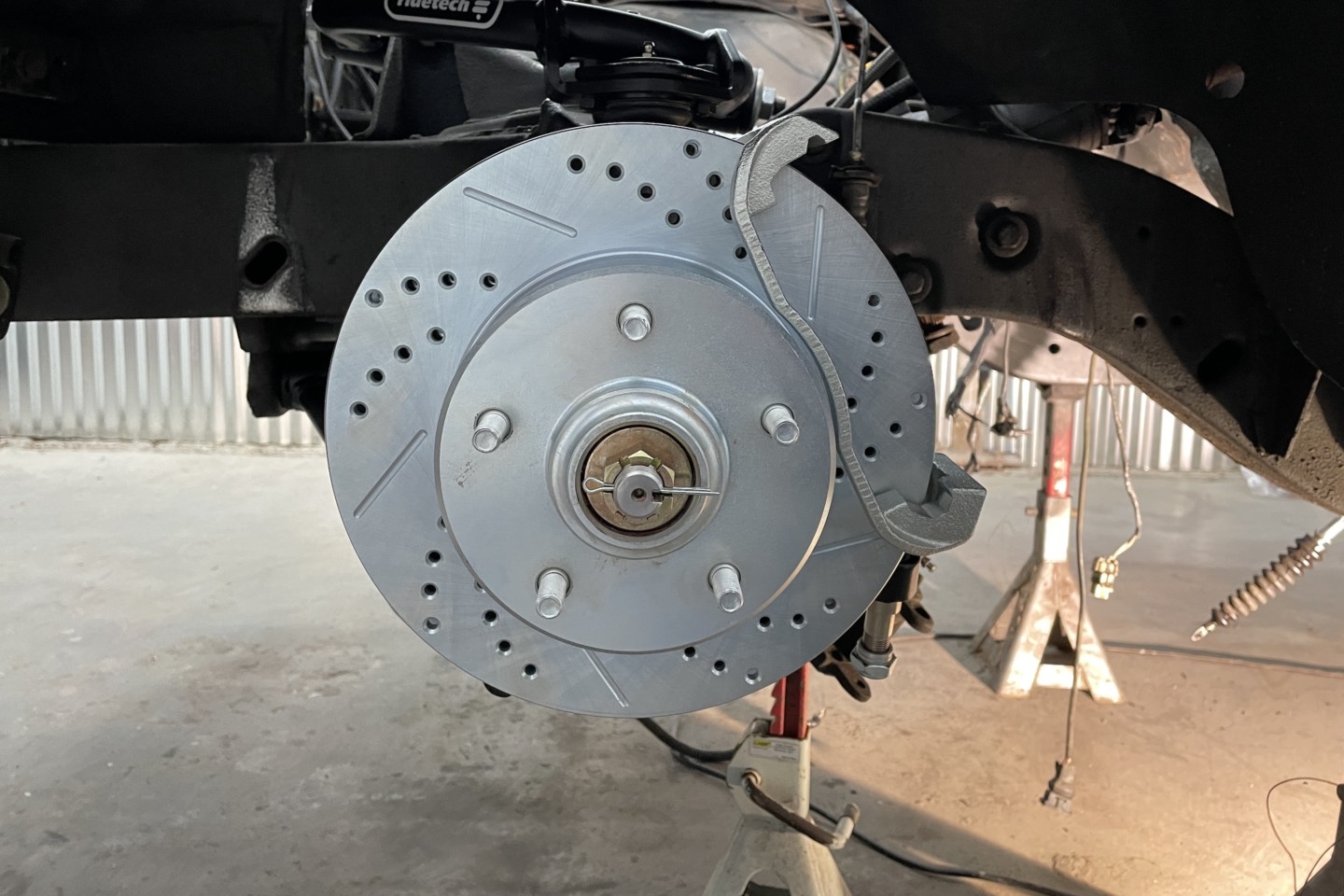
The 11-inch rotor offers plenty of brake pad contact area and large caliper while still fitting inside a stock-style wheel.
Baer’s original brake systems were the perfect way to modernize early muscle cars and now 36 years later, enthusiasts can have that same look with some technological gains. “For the die-hard muscle car fans that want safer modern brakes that still fit stock-style wheels, use off-the-shelf replacement parts, and have a classic look, the Classic series checks all the boxes,” King added. “A larger 13-inch rotor is available in most models for those enthusiasts that want more performance from a larger rotor and don’t mind bigger diameter wheels.”
Baer Brakes Classic Systems:
- GM A-Body front and rear brake sets for 1964 through 1977. Options include an 11- or 13-inch front rotor with a two-piston caliper and a 10.5-inch rear rotor with a single-piston caliper.
- GM F-Body front and rear brake sets for 1967 through 1969. Options include an 11- or 13-inch front rotor with a two-piston caliper and a 10.5-inch rear rotor with a single-piston caliper.
- GM G-Body front brake sets for 1978 through 1987 with an 11-inch rotor and two-piston caliper.
- GM X-Body front and rear brake sets for 1968 through 1974. Options include an 11- or 13-inch front rotor with a two-piston caliper and a 10.5-inch rear rotor with a single-piston caliper.
- Ford Fairlane front brake sets for 1962 through 1970. These sets have 11-inch rotors with two-piston calipers.
- Ford Falcon front brake sets for 1964 through 1970. These sets have 11-inch rotors with two-piston calipers.
- Ford Mustang front brake sets for 1965 through 1973. Options include 11- or 13-inch rotors with two-piston calipers.
- Ford Torino front brake sets for 1969 and 1971 models. These sets have 11-inch rotors with two-piston calipers.
- Mercury Comet front brake sets for 1966 through 1974. These sets have 11-inch rotors with two-piston calipers.
- Mercury Cougar front brake sets for 1966 through 1973. These sets have 11-inch rotors with two-piston calipers.
- Mercury Cyclone front brake sets for 1969 and 1970. These sets have 11-inch rotors with two-piston calipers.
- Ford 9-inch small bearing rearend with 10.5-inch rotor and single-piston caliper rear brake sets for staggered or non-staggered shocks.
- Ford 9-inch big bearing rearend with 10.5-inch rotor and single-piston caliper rear brake sets for staggered or non-staggered shocks.
- Ford 9-inch Torino bearing rearend with 10.5-inch rotor and single-piston caliper rear brake sets for staggered or non-staggered shocks.
- Ford 10- or 12-bolt rearend with 10.5-inch rotor and single-piston caliper rear brake sets for staggered or non-staggered shocks.
About The Installation
Just to say we opted for the Classic series is not enough because Baer offers several different options for most muscle cars in that series. As indicated earlier, there are options for larger rotors and two-piston front caliper in many cases. For our needs, the pros at Baer recommended the 11-inch Classic front brake system (part #4301550), 10.5-inch Classic rear brake system for staggered shock rear suspension setup (part #4302518R), and the Universal 15/16” cast iron master cylinder (part #6150012). Master cylinder bore size depends on several different factors like power assist or not, and driver preferences. We recommend talking with the technicians at Baer Brakes about master cylinder bore size when selecting components for your application.
Baer’s 11-inch Classic front brake system (part #4301550) is designed to be used with OE-type spindles and control arms. Many aftermarket spindles with a two-inch drop (Heidts, Fatman, Ridetech) will also fit this kit. There will be no track width change when replacing stock disc brakes and only 0.200” added track width when replacing factory drum brakes. Baer recommends a master cylinder bore of 15/16” due to the dual-piston design.
The 10.5-inch Classic rear brake system (part #4302518R) features a single-piston, integral park brake caliper mounted to a 10.50-inch dimpled and zinc plated rotor. The caliper comes with a red powdercoated finish, includes a dust seal, and uses the popular D627 pad type. The system includes calipers, rotors, brackets, hardware, stainless braided brake hoses, and fittings. This kit fits most 14-inch or larger wheels and is designed for use with GM’s 10- and 12- bolt rearends with staggered rear shocks. The system has both 5×4.5″ and 5×4.75″ bolt patterns. Like the front brake kit, a 15/16″ bore master cylinder is recommended along with an adjustable proportioning valve (part #2000035).
The rear brake installation requires the axles to be removed to install the caliper bracket, then reinstalled to complete the installation.
We’re not going to reprint or go over every aspect of the installation instructions here, they can be viewed on Baer’s website here: Front Brake Set #4301550, and Rear Brake Set #4302518R. Instead, we are going to highlight some of the key areas in a brake swap of this magnitude, starting with selecting the right size master cylinder. Many enthusiasts overlook master cylinder sizing and the impact this has on the entire brake system when changing calipers. Baer Brakes offers brake master cylinders for just about every muscle car application, so there should not any difficulty finding the right one for your application.

Shims are placed between the caliper mount and the caliper bracket to center the caliper on the rotor. You can see the washer-type shims here on the caliper mount bolts between the mount and the gold-colored caliper bracket.
Master Cylinder Sizing
There are a couple of things to remember when sizing a master cylinder. First, a smaller bore size will increase line pressure and increase the pedal travel. If a smaller bore causes increased line pressure, then the opposite is also true. A larger bore diameter will provide lower line pressure but gives the driver a firmer pedal feel with shorter pedal travel. You can think of higher line pressure as a higher clamping force.

The calipers will need to be shimmed properly to center on the rotor. If the calipers are not centered on the rotor, accelerated wear or component damage could happen. Notice the white circle with the letter “L.” This signifies a rotor that should be installed on the left (driver’s) side of the vehicle. The slots and drilled dimples are manufactured at an angle that takes advantage of the direction of rotation.
So, a change in master cylinder bore size directly affects a pressure change. It also changes the amount of pedal travel realized to add the additional stroke needed to displace enough fluid to move the caliper pistons. This volume ratio plays a crucial role in the clamping capability of the caliper, and the leverage the driver has to use to generate that clamping force.

The completed rear brake assembly. Notice the emergency brake cable mechanism at the bottom of the caliper on the inside.
Second, the master cylinder is only one component in the brake system. The master cylinder is responsible for sending the right amount of pressure and balance to the brake calipers, but it does not function alone. We highly recommend talking with the tech representatives at Baer about master cylinder choices whenever you are changing brake calipers. Properly sized components that work together to allow a driver to stop the car with comfortable leg effort, and provide good handling and performance at the same time is a delicate balance.
For more information on Baer Brakes Classic Series, visit them online at baer.com.




